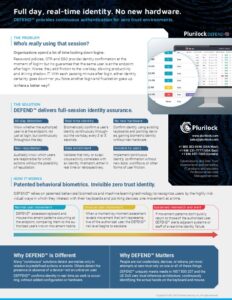In the ever-evolving landscape of cybersecurity, the focus has traditionally been on securing networks, systems, and data. However, as attackers become more sophisticated, there is a growing recognition that user behavior can be a valuable source of information for identifying and preventing security threats. One aspect of user behavior that has gained attention in recent years is mouse dynamics.
Mouse dynamics refer to the unique patterns and characteristics of how an individual interacts with a computer mouse or trackpad. This includes factors such as movement speed, acceleration, deceleration, and the rhythm of clicks. Analyzing these patterns can provide insights into user identity and behavior, contributing to a more robust cybersecurity strategy.
What are Mouse Dynamics?
Mouse dynamics are a subset of behavioral biometrics, a field that focuses on identifying individuals based on their unique physical or behavioral traits. While traditional biometrics like fingerprints and iris scans rely on physical characteristics, behavioral biometrics leverage patterns of behavior, such as keystroke dynamics, voice patterns, and, in this case, mouse movements.
Every person has a distinct way of using a mouse, and this uniqueness can be captured and analyzed to create a behavioral profile. Mouse dynamics are measured by recording and analyzing various parameters, including:
- Speed: The velocity of the mouse cursor as it moves across the screen.
- Acceleration and Deceleration: Changes in the speed of the mouse movement.
- Click Dynamics: The rhythm and timing of mouse clicks, including the duration of clicks and the time between clicks.
- Movement Patterns: The trajectory of the mouse cursor and any distinctive movement patterns.
Why Mouse Dynamics Matter in Cybersecurity
1. Authentication and Access Control
One of the primary applications of mouse dynamics in cybersecurity is user authentication. Traditional methods like passwords and PINs are susceptible to various attacks, including brute-force attacks and password guessing. Behavioral biometrics, including mouse dynamics, offer an additional layer of security by authenticating users based on their unique behavior.
For example, if a user typically moves the mouse in a specific pattern, uses a consistent speed, and has a distinct click rhythm, these patterns can be used to verify the user’s identity. This makes it harder for malicious actors to impersonate legitimate users, even if they have access to the correct credentials.
2. Continuous Authentication
Mouse dynamics enable continuous authentication, which is crucial in today’s dynamic and interconnected environments. Traditional authentication methods are usually performed only at the initial login, leaving a potential vulnerability if a user’s session is hijacked. Continuous authentication, based on mouse dynamics, constantly monitors and verifies the user’s identity throughout their session.
If there are significant deviations from the established mouse behavior, the system can trigger additional authentication steps or automatically log the user out. This ensures that even if an attacker gains access to a valid user’s account, they are less likely to go undetected.
3. Threat Detection and Anomaly Detection
Analyzing mouse dynamics is instrumental in identifying abnormal behavior that may indicate a security threat. Machine learning algorithms can be trained to recognize patterns associated with typical user behavior. When deviations from these patterns occur, it may signal unauthorized access, a compromised account, or an insider threat.
For instance, if a user who typically moves the mouse at a moderate speed suddenly exhibits erratic and fast mouse movements, it could indicate a potential security incident. Combining mouse dynamics with other behavioral biometrics and contextual information enhances the accuracy of anomaly detection systems.
4. Reducing False Positives
Traditional security measures sometimes generate false positives, leading to unnecessary disruptions and inconvenience for users. For instance, an IP address change might trigger a security alert, even if it’s due to a legitimate reason like using a virtual private network (VPN) or connecting from a different location.
Mouse dynamics provide an additional layer of context, helping to reduce false positives. If the mouse behavior remains consistent while other parameters change, it adds confidence to the system that the user is legitimate, reducing the likelihood of unnecessary security alerts.
Importance of Mouse Dynamics in Cybersecurity
1. Uniqueness and Stability
One key advantage of using mouse dynamics in cybersecurity is the uniqueness and stability of the behavioral patterns. Unlike physical characteristics that can change over time (e.g., fingerprints can be altered due to injuries), mouse dynamics tend to remain relatively stable for individuals.
Users typically develop consistent habits and patterns in their mouse movements over time, making it a reliable biometric identifier. Even subtle changes in mouse behavior can be detected, providing a reliable method for continuous authentication and threat detection.
2. User-Friendly Authentication
From a user experience perspective, mouse dynamics offer a non-intrusive and user-friendly authentication method. Users are not required to remember complex passwords or go through additional steps, as their natural behavior with the mouse serves as the authentication factor.
This approach aligns with the growing emphasis on usability in cybersecurity. By leveraging something as simple as the way users move their mouse, organizations can enhance security without compromising the user experience.
3. Multi-Factor Authentication Enhancement
Mouse dynamics can complement traditional multi-factor authentication (MFA) methods, such as passwords and one-time codes. Adding behavioral biometrics as an additional authentication factor strengthens the security posture by requiring attackers to not only possess the correct credentials but also mimic the user’s unique behavior.
This layered approach makes it significantly more challenging for adversaries to compromise accounts, especially when considering the combination of multiple biometric and non-biometric factors.
4. Adaptive Security
The adaptability of mouse dynamics to different environments and scenarios is a crucial aspect of its importance in cybersecurity. Users may access systems from various devices, locations, and networks. Mouse dynamics can adapt to these changes and provide a continuous authentication process that accommodates the dynamic nature of modern computing environments.
As users naturally adapt their mouse behavior based on the device they are using or the context of their work, incorporating mouse dynamics into the authentication process enhances security without imposing rigid constraints on user behavior.
Challenges and Considerations
While mouse dynamics offer valuable benefits in cybersecurity, there are challenges and considerations that organizations need to address:
1. Privacy Concerns
Collecting and storing behavioral biometric data, including mouse dynamics, raises privacy concerns. Organizations must implement robust security measures to protect this sensitive information. Transparent and well-defined privacy policies, as well as compliance with relevant regulations, are essential to ensure user trust and legal compliance.
2. User Acceptance
User acceptance is critical for the success of any authentication method. Organizations should communicate the benefits of mouse dynamics in enhancing security while minimizing disruptions to the user experience. Providing users with control over their biometric data and offering opt-in mechanisms can foster trust and acceptance.
3. Continuous Monitoring
Implementing continuous authentication based on mouse dynamics requires continuous monitoring of user behavior. This can lead to concerns about surveillance and may require clear communication with users about the purpose and scope of the monitoring. Striking the right balance between security and user privacy is crucial.
4. Adversarial Attacks
As with any biometric authentication method, mouse dynamics are not immune to adversarial attacks. Sophisticated attackers may attempt to mimic the user’s mouse behavior or find ways to manipulate the system. Ongoing research and development are essential to stay ahead of potential adversarial threats.
Conclusion
Mouse dynamics represent a promising frontier in the realm of cybersecurity, offering a unique and user-friendly approach to authentication and threat detection. By harnessing the individuality and stability of mouse behavior, organizations can enhance their security posture, reduce the risk of unauthorized access, and improve the overall user experience.
As technology continues to advance, the integration of mouse dynamics into cybersecurity frameworks provides a scalable and adaptable solution for the evolving threat landscape. While challenges such as privacy concerns and user acceptance need to be addressed, the potential benefits of leveraging mouse dynamics make it a compelling avenue for organizations looking to bolster their defenses in an increasingly digital world. As we move forward, the intersection of behavioral biometrics, artificial intelligence, and cybersecurity promises to redefine how we approach identity verification and access control in the digital age.













